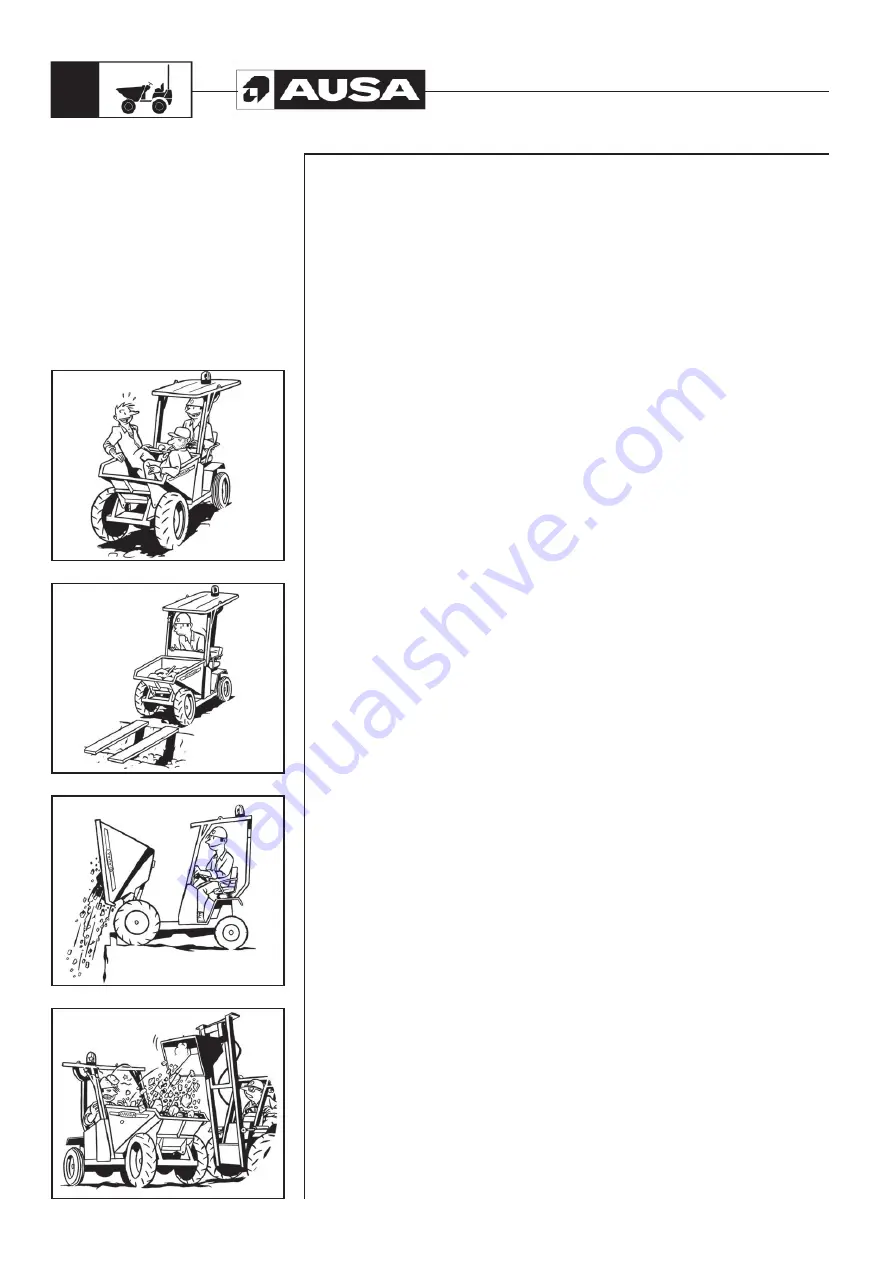
D201RH / RHS / RHG / RHGS
16
Special
Safety
Messages
(fi
g.
1)
(fi
g.
2)
(fi
g.
3)
(fi
g.
4)
Pedestrians in the surrounding area
It is forbidden to carry persons on the dumper
(fig. 1)
.
No-one is permitted to remain or cross below the bucket when this is raised, laden or
unladen.
Give way to the right to pedestrians found in your path.
Access and doors
Make sure that the passages and doors along the route are sufficiently high to allow the
entire dumper to pass.
When carrying out lifting and dumping manoeuvres, pay special attention to the height
of the roof, lighting and other overhead installations.
Ground surface
Check that the ground is strong enough to bear the dumper when loaded, especially
when approaching bridges, the edges of embankments, concrete flooring, elevators,
etc.
(fig. 2)
.
Lighting
The dumper working area should be adequately lit to prevent the risk of accidentally
running over persons or colliding with obstacles. As soon as the daylight fades, the
dumper lighting system should be switched on. If the dumper is not equipped with
lighting, make sure that the working area is adequately lit. If this is not possible, do not
continue working with the dumper, this may result in an accident.
The loading bay. Communication. Shelving and installations.
The load
The loading bay or area where the loads are handled should be correctly equipped
and signposted. The operating area of the dumper should be free of obstacles and
pedestrians, however if their presence is necessary, the pedestrians should move in
areas which have been duly marked as such and they should be easily distinguished,
for example, by wearing reflective jackets.
If the area is closed it should be well-ventilated and the dumper must be equipped with
lighting and exhaust gas purifier systems.
The dumper operator should be able to communicate normally with pedestrians. If
the surrounding area is excessively noisy, pedestrians should refrain from walking in
the immediate vicinity. If this is unavoidable, the utmost care should be taken. Radio
communication equipment should not be handled while driving the dumper. If it is
necessary to use the radio, pull over to one side and signal the position of the dumper,
using the lights or hazard warning lights.
Before handling a load using the dumper, check the load and ensure that its weight does
not exceed its capacity. At the same time, check that the load is stabilized and correctly
secured, to ensure that no part of the load falls off during transportation.
Do not dump the bucket contents over a bank or slope without ensuring stability and
until there is a rail that will act as a stop for the wheels. A plank on the ground cannot be
considered as an acceptable safety stop
(fig. 3)
.
When the dumper is loaded using a shovel, crane or other similar external method, the
driver should not remain in the driver’s cab
(fig. 4)
.
Dump the load progressively paying careful attention to the dumper stability. Avoid
transporting material that may stick or jam in the bucket, such as clay type mud, large
stones or rubble; the dumper may become unstable during unloading and cause an
accident.
Summary of Contents for D 201 RH
Page 1: ...D 201 RH D 201 RHS D 201 RHG D 201 RHGS OPERATOR S MANUAL ENGLISH Original Manual ...
Page 2: ......
Page 3: ...D 201 RH D 201 RHS D 201 RHG D 201 RHGS Original Manual Above chassis number 62439 ...
Page 4: ......
Page 66: ...D201RH RHS RHG RHGS 64 Electric Diagram H1 ...
Page 67: ...D201RH RHS RHG RHGS 65 Electric Diagram H2 ...
Page 68: ...D201RH RHS RHG RHGS 66 Electric Diagram H3 ...
Page 69: ...D201RH RHS RHG RHGS 67 Electric Diagram H4 ...
Page 72: ...D201RH RHS RHG RHGS 70 D 201 RH hydraulic diagram ...
Page 73: ...D201RH RHS RHG RHGS 71 D 201 RHS hydraulic diagram ...
Page 74: ...D201RH RHS RHG RHGS 72 D 201 RHG hydraulic diagram ...
Page 75: ...D201RH RHS RHG RHGS 73 D 201 RHGS hydraulic diagram ...
Page 76: ...D201RH RHS RHG RHGS 74 Transmission hydraulic diagram ...
Page 78: ......
Page 79: ......
Page 80: ......































